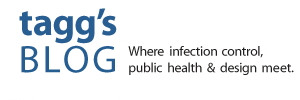Yesterday was the fifth of May, which is the World Health Organization’s yearly celebration and promotion of hand hygiene and its role in saving lives.
What a day it was! There were a great many photos of healthcare workers and policy people shared on Instagram and Twitter, each of them holding a printout of the hashtag #safeHANDS, and adding their collective energy to the proceedings. All told, it went swimmingly for all who were involved with organizing it.
There were also teleclasses and webinars held on various subjects – one featured a retrospective on the past year in the WHO 5 Moments campaign (which has been globally successful), a look at the challenges in Afghanistan’s hospital system, and perhaps most interesting to us a look at what works and what doesn’t for promoting hand hygiene.
That particular presentation is up on Youtube, and we’ve queued it up here to the part we find most fascinating.
It sounds exactly like one of our “Healthcare Graphics Need Help” columns, doesn’t it?
Robert Aunger (who has written several books on interesting topics) goes on to narrow down what’s been tried and doesn’t work from a behavioural science point-of-view. He doesn’t say what does work – other than that nothing we’ve tried so far works everywhere – but does lay out things that successful hand hygiene promotion should do if it hopes to minimize resistance.
In going over the diagram at the end of his segment, when we look at the words that are not red (and therefore good for promotion) we see certain themes pop up. “Peer-group solidarity,” “Identity,” “Habits,” and “Norms: Modify Expectations.”
“Reframe Hand Hygiene” was one other idea, which was reinforced by Jules Storr (an infection prevention consultant to the WHO) who stated in an unrelated presentation earlier today that the “future is embedding hand hygiene, not presenting it as added work.”
Why does all of this interest us? Over a year ago, we wrote a blog post called “What Can Hand Hygiene Learn from Fire Safety?” In it, we talked at length about the value that a public health campaign has when it gets everyone invested in protecting our own health and that of our loved ones.
It’s not just the field of fire safety that’s comparable. If you think about it, oral hygiene has a tremendous impact on our society’s health. People are trained to brush and floss from a young age. Road safety systems use signage and universal symbols to bring safety to a large group – drivers – in a way that also benefits pedestrians and businesses who rely on traffic flowing smoothly and safely.
The main difference in thinking between current hand hygiene promotion and this different public health approach is that the public health approach considers everybody. Children? Yup. Office workers? Absolutely! Families? That’s the fastest way to spread it!
If people are performing infection control procedures (that’s what hand hygiene is!) in their day-to-day life, then society as a whole stands to benefit. There will be fewer cases of influenza, the common cold, and enterovirus. Fewer food recalls, cruise-ship outbreaks, and accidental hospital acquired infections.
Of course, that includes healthcare workers. Why wouldn’t it? They are people too and people are connected to other people. Hospital visitors are connected to patients and patients to doctors. All of these are troublesome targets that current hand hygiene promotion doesn’t even like to think of.
So in closing, we were right all along. Those silly germy posters and funny hand hygiene videos are distractions – they do not promote successfully to everyone, even the groups that they claim to target. If we want to see real across-the-board growth in the field of hand hygiene, we need a broad, multi-modal, societal approach that doesn’t limit itself to healthcare.


[…] users – visual acuity, literacy and physical factors are all possible barriers. This is something we’ve written about copiously, and it’s something that does take some real time, effort and artistry to do correctly, but when […]